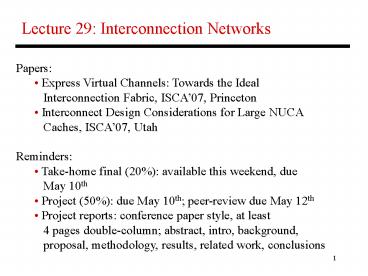Lecture 29: Interconnection Networks - PowerPoint PPT Presentation
Title:
Lecture 29: Interconnection Networks
Description:
... (an EVC is a VC reserved across multiple routers) similarly, the EVC is also guaranteed the switch (only 1 EVC can compete for an output physical channel) ... – PowerPoint PPT presentation
Number of Views:78
Avg rating:3.0/5.0
Title: Lecture 29: Interconnection Networks
1
Lecture 29 Interconnection Networks
- Papers
- Express Virtual Channels Towards the Ideal
- Interconnection Fabric, ISCA07, Princeton
- Interconnect Design Considerations for Large
NUCA - Caches, ISCA07, Utah
- Reminders
- Take-home final (20) available this weekend,
due - May 10th
- Project (50) due May 10th peer-review due May
12th - Project reports conference paper style, at
least - 4 pages double-column abstract, intro,
background, - proposal, methodology, results, related work,
conclusions
2
Router Pipeline
- Four typical stages
- RC routing computation compute the output
channel - VA virtual-channel allocation allocate VC for
the head flit - SA switch allocation compete for output
physical channel - ST switch traversal transfer data on output
physical channel
Cycle 1 2 3 4
5 6 7 Head flit Body flit 1 Body
flit 2 Tail flit
RC
VA
SA
ST
--
--
SA
ST
--
--
SA
ST
--
--
SA
ST
3
Express Physical Channels
- Express channels connect non-adjacent nodes
flits traveling a long distance - can use express channels for most of the way
and navigate on local channels - near the source/destination (like taking the
freeway) - Helps reduce the number of hops
- The router in each express node is much bigger
now
4
Express Virtual Channels
- To a large extent, maintain the same physical
structure as a - conventional network (changes to be explained
shortly) - Some virtual channels are treated differently
they go through a - different router pipeline and can effectively
avoid most router - overheads
5
Router Pipelines
- If Normal VC (NVC)
- at every router, must compete for the next VC
and for the switch - will get buffered in case there is a conflict
for VA/SA - If EVC (at intermediate bypass router)
- need not compete for VC (an EVC is a VC reserved
across - multiple routers)
- similarly, the EVC is also guaranteed the switch
(only 1 EVC can - compete for an output physical channel)
- since VA/SA are guaranteed to succeed, no need
for buffering - simple router pipeline incoming flit directly
moves to ST stage - If EVC (at EVC source/sink router)
- must compete for VC/SA as in a conventional
pipeline - before moving on, must confirm free buffer at
next EVC router
6
Bypass Router Pipelines
- Non aggressive pipeline in a bypass node an
express flit simply - goes through the crossbar and then on the link
the prior SA stage - must know that an express flit is arriving so
that the switch control - signals can be appropriately set up this
requires the flit to be - preceded by a single-bit control signal
(similar to cct-switching, but - much cheaper)
- Aggressive pipeline the express flit avoids the
switch and heads - straight to the output channel (dedicated
hardware) will still need - a mechanism to control ST for other flits
7
Dynamic EVCs
- Any node can be an EVC source/sink
- The EVC can have length 2 to lmax
8
VC Allocation
- All the VCs at a router are now partitioned into
lmax bins - More buffers for short-hop EVCs
- Flow control credits have to propagate lmax
nodes upstream - Can also dynamically allocate buffers to EVCs
(although - one buffer must be reserved per EVC to avoid
deadlock) - EVCs can potentially starve NVCs at bypass
nodes if a - bypass node is starved for n cycles, it sends
a token - upstream to prevent EVC transmission for the
next p cycles
9
Ideal Network
- Fully-connected every node has a dedicated link
to every other node - Bisection bandwidth
- For a 7x7 network, Ledge will be 69mm and chip
area will be 4760mm2 - (for a single metal layer)
- An ideal network will provide the least latency,
least power, and - highest throughput, but will have an inordinate
overhead, as - specified above
10
Approaching the Ideal Network
- The interconnection network
- models employ different forms
- of speculative router pipelines
11
Results
- Roughly 40 of all nodes are bypassed
12
Non-Uniform Cache Access
From Beckmann et al. (MICRO04) and Huh et al.
(ICS05)
13
Improving NUCA Methodologies
- Design space exploration iterate
- over bank counts, organizations,
- and destinations to compute the
- optimal cache structure
14
Forms of Heterogeneity
- Different networks for data and address the
latter has lower - bandwidth demands and can employ faster wires
on higher metal layers - Parts of the address are more critical the
index bits are transmitted - on low-latency links so that cache access can
begin early the rest - of the address arrives in time for tag
comparison
15
Hybrid Network Topology
16
Title
- Bullet































